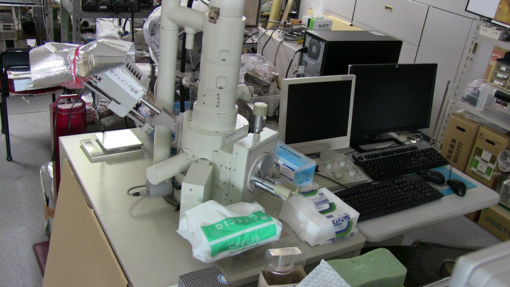Nuclear chemist and veteran LENR researcher Dr. Tadahiko Mizuno is now in the recovery phase after an earthquake damaged sensitive equipment in his laboratory in Hokkaido, and the CMNS community is assisting in the repair and replacement of lab apparatus that will allow him to continue his successful excess heat research.
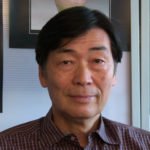 “I have experienced earthquakes many times before. Each one was terrible, but this time it was a bit different,” said Dr. Mizuno of the shaking.
“I have experienced earthquakes many times before. Each one was terrible, but this time it was a bit different,” said Dr. Mizuno of the shaking.
“The fact that the laboratory was hurt by the unexpected, the fact that the building was broken – and the biggest thing is that electricity and water stopped for a few days. Earthquakes up to that point did not have that kind of thing, rather it was very localized. This time, the lab would clearly be effected.”
Like many scientists in Japan, Dr. Mizuno had prepared for a disaster like this. He says,
“Naturally, this kind of situation was contemplated. A few years ago Sapporo produced a scenario of a devastating earthquake, with almost all the buildings collapsed. There was no electricity, no water, no food- it was a cold winter game-plan. It was so realistic, it was a revelation to seriously prepare for disaster prevention.”
“We fixed everything that we could install, such as fixing shelves, setting fire extinguishers, emergency food, water, power generation radio. Of course I persuaded others to proceed with preparation. I was warning everyone!”
“A few days before, a metallic ringing continued in my ears, and an earthquake came in the middle of the night when it stopped. No matter how much preparation it was, the damage was something I could not escape.”
The quake on 3/11/11 which caused the ensuing tsunami and Fukushima disaster was foremost in his mind.
“I also had the same experience on March 11, 2011. At that time I took a day off and was vegetating in front of the TV. A loud audible alarm sounded from the TV and mobile phone, and soon a big earthquake swing came. I think everyone is aware of the situation of the subsequent disasters.”
“At that time, I was preparing CF experiments to control the heat. It seems that it was telling me to hurry again this time. I feel such a presence of God.”
Glow discharge makes significant excess power
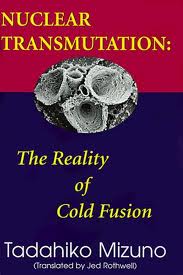 Dr. Mizuno has been investigating both LENR excess heat and transmutations since 1989. He has written and edited several books, among them, Nuclear Transmutation: The Reality of Cold Fusion published in 1998, detailing the massive excess heat he witnessed in his earliest experiments, and the slow realization over years that there were also transmutations occurring, too.
Dr. Mizuno has been investigating both LENR excess heat and transmutations since 1989. He has written and edited several books, among them, Nuclear Transmutation: The Reality of Cold Fusion published in 1998, detailing the massive excess heat he witnessed in his earliest experiments, and the slow realization over years that there were also transmutations occurring, too.
Working as Hydrogen Engineering Application & Development HEAD, Dr. Mizuno has been part of the extraordinary collaboration between industry and academia in Japan, recently working with Clean Planet, Inc and the Condensed Matter Nuclear Science CMNS division at the Research Center for Electron Photon Science ELPH at Tohoku University.
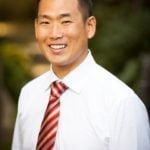 Hideki Yoshino, the founder and CEO of Clean Planet and an organizer of collaborative LENR research, reported on Mizuno’s work at the CF/LANR Colloquium at MIT in 2014.
Hideki Yoshino, the founder and CEO of Clean Planet and an organizer of collaborative LENR research, reported on Mizuno’s work at the CF/LANR Colloquium at MIT in 2014.
In that presentation, Yoshino described results from 73 tests of Mizuno’s gas discharge system where a treated nickel mesh cathode reacted with D2 gas at temperatures above 200 degrees C and pressures of 100-300 pascals using a palladium rod wrapped in palladium wire as an anode.

In one test run, a total input power of 80 Watts produced 78 Watts excess thermal power out. Continuing for 35 days before it was turned off, the total excess energy produced was 108 MegaJoules.
The only problem? Reactions would not start sometimes until one, two, even three years later! A new method of preparing the electrodes would have to be found in order to create a reaction more quickly, and explore the parameter space of the system.

In the paper Observation of Excess Heat by Activated Metal and Deuterium Gas published in JCMNS V25 [.pdf], Mizuno writes,
“With unprocessed nickel, it is impossible to generate excess heat at all. However, if the surface is covered with particles and further Pd is present on the surface, excess heat is easily generated. The smaller the particles are, and the more Pd is uniformly present, the more the excess heat is generated.”
A new method treats the nickel by physically rubbing the palladium rod on the mesh before glow discharge begins. A second new method used electroless plating to plate palladium on the nickel mesh.
Mizuno excess power experiment is reproduced
At the 21st International Conference on Condensed Matter Nuclear Science ICCF-21 held June 2018, Jed Rothwell presented some of the results of experiments using the new methods of electrode preparation.
See the ICCF-21 video presentation on Tadahiko Mizuno’s work here. Download the presentation .pdf file here.
Jed Rothwell runs the LENR science paper archive http://lenr-canr.org/ and is the author of Cold Fusion and the Future [.pdf]. He has translated many of Dr. Mizuno’s papers and books from Japanese into English. Mizuno writes:
“Jed has been involved in our research of CF work for 25 years, from 1993 to 2018. He analyzed our testing methods, our adiabatic thermal measurement method, and our air cooling method test results. He found problems and contributed to many improvements of the test method. Jed himself wrote the manuscript paper and based on these many contributions, Jed is the co-author of that paper.”
He added,
“He has also struggled to collect research funds for us. Without this funding, our CF work may have been impossible.”

In the ICCF-21 presentation, Rothwell revealed that the new methods of electrode preparation have successfully decreased the time to reaction to about a week or two, but sadly, the change in materials preparation has reduced power output to only 5-20% of previous values, now measuring about 20-40 Watts excess thermal.
For 38 active tests, 19 using each of the two new methods, all tests but five produced about 5% excess power, with five of those 38 tests producing 15% or more excess thermal power.
There have been valid concerns with his data, and Dr. Mizuno has been responsive. For instance, he showed that the resistance heater is not part of the excess by performing glow discharge with an ordinary nickel mesh (without treatment) and producing only the amount of heat as resistance heating.
It seems addressing the objections has only strengthened the conclusions, as they should.
In fact, a team of scientists Takehiko Itoh, Yasuhiro Iwamura, Jirohta Kasagi from ELPH at Tohoku University and Hiroki Shishido from the Quantum Science and Energy Engineering Department also at Tohoku University, were able to successfully reproduce excess heat using a system almost identical to Mizuno’s, though with less heat output, only generating about 7 Watts thermal. [See Anomalous Excess Heat Generated by the Interaction between Nano-structured Pd/Ni Surface and D2 Gas in JCMNS V24 [.pdf].]
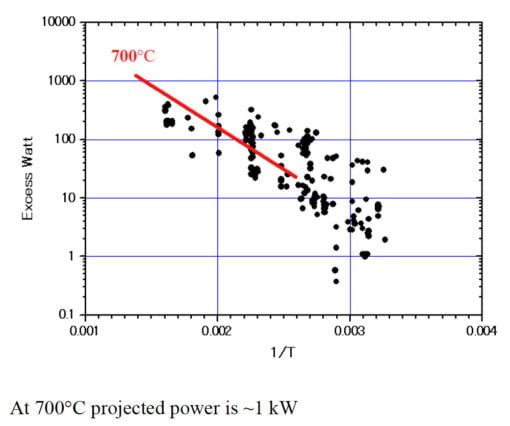
Mizuno believes that extrapolating data relating temperature and excess power (here showing the earlier high-output data) to 700 degrees C could produce 1 kiloWatt of excess thermal power, a number Jed Rothwell notes is “much better energy density and Carnot efficiency than a fission reactor core.”
Community generosity is rewarded with test reactor
When the 6.7 earthquake hit Hokkaido on September 6, 2018, damage to the sensitive lab equipment was enough to spell an end to research. At 73 years young, it’s not easy to start over again. Describing the damage to the lab, Dr. Mizuno was optimistic about repairs saying,
“Although the shelf did not collapse, inside the lab was knocked-about. The SEM, the fluorescent X-ray equipment, and the experimental equipment which had just been installed, moved around as much as 10 cm, and the connections and vacuum were destroyed.”
“Fortunately, there is a lot of experience around able to repair the equipment, and we can fix some too, if we can make the time.
The CMNS community came together to help. Physicist and LENR scientist Dr. Dennis Cravens started a gofundme fundraiser to help with costs:
“Do unto others. If Tadahiko is correct, it is a promising path that he should continue to follow. He had been working alone without encouragement for years – and there were many years early on with no results. I know how that must feel- being alone and unappreciated. I have had many years like that.”
“We raised about $8,500 dollars. The amount sent was lightly adjusted by Go Fund Me fees and currency exchange costs getting it here to there. I should also say a few people wired money directly.”
That generosity will stretch a long way to fix the equipment, and spirits. Upon hearing of the campaign, Mizuno was overcome:
“I am very thankful to everyone for helping me. I thought for a long time that I was studying CF work all alone. I thought it was checkmate due to the earthquake damage on 6th September. I was pessimistic that I could not repair the equipment, and all was over. However, that was not so. Many friends have stepped up and supported my CF research. I was so happy, tears came to my eyes. This was the first time I have felt this way during the more than 70 years I have been alive. I am very happy that people were so kind, and am happy thinking about it. I am very grateful to everyone. I will never forget the efforts of my friends.”
Dr. Mizuno wanted to do something special and so he offered up one of his reactors to a researcher in the community to test.
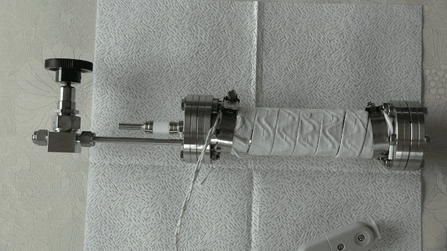
“The money you raised will be used to repair my equipment, especially the scanning electron microscope, and, part of the money will be used for the production cost of a small reactor that I am sending to another lab that has agreed to test it. I think it will produce excess heat. And I think that other researchers in the world will confirm and announce excess heat generation by these methods. Thank you again.”
 Sindre Zeiner-Gundersen is Director of Operations of Norrønt AS, a company providing engineering project management and patent development. He is also a PhD candidate in Physics who has been researching ultra-dense hydrogen and Rydberg matter with PhD supervisor Svein Olafsson in Iceland and Norway’s Professor Svein Holmlid.
Sindre Zeiner-Gundersen is Director of Operations of Norrønt AS, a company providing engineering project management and patent development. He is also a PhD candidate in Physics who has been researching ultra-dense hydrogen and Rydberg matter with PhD supervisor Svein Olafsson in Iceland and Norway’s Professor Svein Holmlid.
Zeiner-Gundersen, based in the Oslo-area of Norway, has just received the reactor from Mizuno.
“I’m guessing I was one of the first to contact Mizuno after his lab went down in the earthquake, to continue and verify his important work, and I’m also working in a well equipped lab as well. Opening the shipping box was like Christmas. All the excitement in the world.”
“I believe its not the glow discharge reactor but filled with ZrPd powder that will activate when the temperature reaches a critical point after being loaded with deuterium. I think this is the same design that yielded 12% excess heat that Jed presented at ICCF21.”
“I’m still waiting for further operating instructions before testing and I’m setting up flow calorimetry, and programming Labview data acquisition to measure everything from: voltage, current, 8 temp sensors, pressure, charged particles, alfa, beta, gamma and neutrons.”
The CMNS community, long isolated from mainstream support, knows that working together is the path to success. Sindre Zeiner-Gundersen maintains
“… the most valuable work we as researchers can do is to collaborate, share data, replicate and verify the work preformed by the best researchers in this field.”
After 30-years of breakthrough research, Tadahiko Mizuno is just getting started. He’s organizing the lab again for a new round of experiments and consulting on a reproduction half-way around the world. When asked if he will be able to build upon such spectacular results he says:
“It is all about making an excess-heat generation CF device. There is no reason not to be able to do it. This is my job.”

